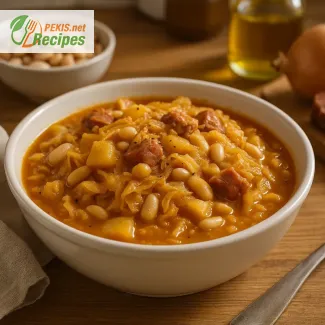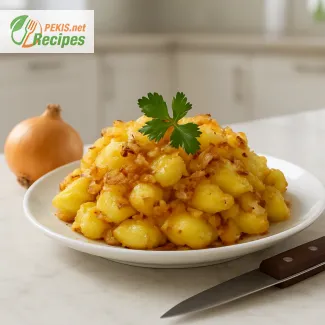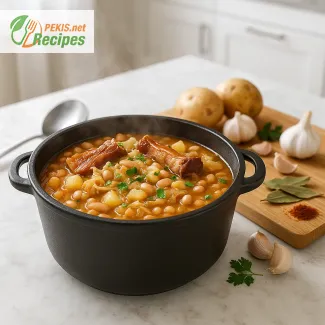
Discover the Rich Tradition of Jota: A Hearty Slovenian Stew Rooted in Alpine Heritage
How sauerkraut, beans, and centuries of tradition create the perfect comfort food
In the lush Alpine landscapes of western Slovenia, a dish has been simmering for generations—Jota, a deeply traditional Slovenian stew that brings together humble ingredients with bold, rustic flavor. Born in the Primorska region and nurtured through centuries of culinary tradition, this bean and sauerkraut stew is more than just food; it's a reflection of Slovenian cultural identity, shaped by its history, climate, and agrarian roots.
While its name may sound unfamiliar outside Central Europe, Jota (pronounced yoh-tah) is a staple of Slovenian households, especially during colder months. It exemplifies a sustainable and frugal kitchen, using fermented cabbage, dried beans, potatoes, and often a hint of smoked pork or bacon—ingredients that were readily available in rural pantries through long winters. Yet its flavor is far from modest. Through careful layering, slow cooking, and a balance of acidity and richness, Jota emerges as a dish that’s both comforting and surprisingly refined.
A legacy born from necessity and perfected by generations
The origins of Jota can be traced to border regions between Slovenia and Italy, particularly the Karst Plateau, where communities developed hearty dishes that could feed large families on minimal resources. In the absence of refrigeration or imported produce, Slovenians turned to fermentation, drying, and cellar storage—leading to staples like kislo zelje (sauerkraut) and fižol (beans) becoming everyday essentials.
Jota was typically cooked in clay or iron pots over wood-fired stoves, developing a slow-cooked depth that modern pressure cookers and instant pots aim to replicate today. The combination of tangy sauerkraut with creamy white beans forms the foundation, while smoked meat like pancetta, pork neck, or sausage often enhanced both taste and nutrition. Over time, families customized the recipe with subtle variations—some adding garlic, others preferring it thicker with more potatoes, or spiced with bay leaf and black pepper.
What remained constant is its role: a warming meal shared during winter, particularly around holidays or after working the land. It was, and still is, a symbol of Slovenian resilience, resourcefulness, and communal tradition.
Modern appeal of an old-world recipe
In today’s kitchens, Slovenian Jota is enjoying renewed attention not only from nostalgic home cooks but also from international food lovers eager to explore authentic Eastern European flavors. Its natural fermentation, plant-based ingredients (when made without meat), and hearty texture make it a favorite among those seeking gut-friendly, vegetarian, or wholesome comfort meals. Many even consider it a candidate for anti-inflammatory diets due to the presence of fermented cabbage and legumes.
Moreover, its adaptability makes it suitable for contemporary tastes. Whether served with crusty sourdough bread, finished with a swirl of olive oil, or enriched with vegan sausage alternatives, Jota transitions seamlessly from peasant roots to a sophisticated starter or main dish in modern menus.
Restaurants in Ljubljana, Nova Gorica, and Bovec now feature it as a highlight of local cuisine, often presented alongside dishes like Idrija žlikrofi or Kranjska klobasa. Food tourism in Slovenia increasingly includes Jota tastings, especially in agritourism farms (kmetije), where it’s made using time-honored recipes passed down for generations.
Cultural importance and regional pride
What makes Jota so significant in Slovenian cuisine is its regional authenticity. Unlike more pan-Slavic dishes like goulash or cabbage rolls, Jota has a geographical and cultural specificity that sets it apart. While versions of fermented cabbage stews exist across Central Europe, the Slovenian Jota—particularly that from Primorska, Goriška Brda, and the Soča Valley—is unique in its flavor profile, preparation, and identity.
In some families, Jota is served at New Year celebrations or as a post-fasting meal, symbolizing grounding, nourishment, and the comfort of tradition. Its preparation is often a shared ritual, with recipes written in notebooks, handed down from grandmothers, and refined in family kitchens where each spoonful tells a story.
Beyond Slovenia, the dish has influenced neighboring Friulian cuisine in Italy, where a version of Istrian jota is served, albeit with different proportions of meat and beans. Still, the heart of Jota remains distinctly Slovenian—earthy, generous, and quietly powerful.
Why Jota continues to matter today
In an era when food is often fast, processed, or trend-driven, Slovenian Jota offers a return to fundamentals: honest ingredients, slow preparation, and soulful taste. It aligns with global shifts toward sustainability, zero-waste cooking, and the rediscovery of heritage recipes. And while it may not be as widely recognized as Italian minestrone or French cassoulet, those who taste it often find it unforgettable.
Whether you’re Slovenian by heritage or simply curious about hidden gems of European cooking, preparing Jota at home is a journey worth taking. It connects you not just to a recipe, but to a people, a land, and a tradition that has stood the test of time—one delicious bowl at a time.
- In a large pot, heat the sunflower oil (30 ml / 2 tbsp) over medium heat. Add the finely chopped onion (150 g / 5.3 oz) and sauté until translucent, about 5–6 minutes.
- Add the minced garlic (2 cloves) and stir for another minute until fragrant.
- If using smoked pork or pancetta (150 g / 5.3 oz), add it now and lightly brown it for 4–5 minutes.
- Add the sauerkraut (500 g / 1.1 lb) to the pot. Stir and cook for 10 minutes, allowing the kraut to soften slightly.
- Add the peeled and diced potatoes (300 g / 10.5 oz) and pour in the water or vegetable broth (1 L / 4 ¼ cups). Bring to a gentle boil.
- Add the bay leaves (2 pieces), salt (5 g / 1 tsp), and black pepper (1 g / ¼ tsp).
- Cover and simmer over low heat for 45–50 minutes, or until the potatoes are fully tender and the flavors have melded together.
- Stir in the cooked white beans (400 g / 14 oz) and let cook for another 15 minutes.
- In a small pan, make a light roux: heat a small amount of oil and stir in the flour (10 g / 1 tbsp) until golden. Stir the roux into the jota to slightly thicken it.
- Remove the bay leaves, adjust seasoning if needed, and serve hot.
Elevating the Taste of Slovenian Jota: Expert Tips and Ingredient Tweaks
Discover how to personalize and refine this hearty sauerkraut and bean stew for modern kitchens
Slovenian Jota, with its base of sauerkraut, beans, and potatoes, is inherently humble yet full of potential. While the traditional version is deeply satisfying, cooks around the world are discovering ways to enhance its flavor, refine its texture, and even make it more aligned with contemporary dietary preferences. Whether you're trying to perfect your family recipe or explore regional twists, small changes can transform this comforting stew into something exceptional.
How ingredients influence flavor depth
The beauty of Jota lies in its balance between acidity, earthiness, and savoriness. One of the most effective ways to enhance its character is by playing with these taste profiles through your ingredient selection.
Use homemade sauerkraut
While store-bought sauerkraut is convenient, fermenting your own cabbage produces a richer, more nuanced sourness without excessive salt or preservatives. The result is a deeper umami character that complements the beans and potatoes rather than overpowering them.
Add smoked elements mindfully
Traditional Jota sometimes includes smoked pork or pancetta, which infuses the stew with warmth and complexity. For even greater depth, consider adding a small amount of smoked paprika or a roasted garlic puree. If you're preparing a vegetarian version, a drop of liquid smoke or a piece of smoked tofu can add body and dimension without altering the core integrity of the dish.
Beans: cooked from dry vs. canned
Canned beans work in a pinch, but beans cooked from dry—especially soaked overnight and simmered with aromatics—offer better texture and flavor. They hold their shape longer in the stew and absorb more of the surrounding broth, creating a creamy interior that canned beans often lack.
Broth quality matters
Instead of plain water, use a light vegetable or homemade meat broth to simmer the stew. A well-made broth elevates every other component and gives Jota a fuller, rounder flavor. Avoid overly salty bouillon cubes, which can clash with the sauerkraut’s natural saltiness.
Small adjustments, big impact
Even within traditional guidelines, subtle tweaks can personalize Jota while preserving its identity.
A touch of acidity
A splash of apple cider vinegar or a squeeze of lemon juice right before serving can brighten the overall profile, especially if the sauerkraut has mellowed during cooking. This is particularly useful if the stew tastes flat or heavy.
Herbs and aromatics
Bay leaf is standard, but adding a sprig of fresh thyme, a pinch of caraway seeds, or even a light dusting of nutmeg can subtly shift the aromatic foundation. These additions won’t dominate but will contribute layers of complexity to each spoonful.
Texture balancing
Some cooks like their Jota thick and rustic; others prefer it slightly soupier. If you want more body, mash a few of the potatoes against the side of the pot or stir in a spoonful of potato starch instead of flour. For a lighter consistency, simply reduce the roux or dilute with extra broth.
Why homemade always wins
Preparing Jota from scratch allows for ingredient control, flavor layering, and cooking timing that mass-produced versions cannot match. Home cooks can adjust salt levels, customize the degree of sourness, and control how soft or firm each component is.
Moreover, the emotional and cultural value of making this dish in your own kitchen enhances the experience. Whether it's following a family recipe or experimenting with new variations, homemade Jota fosters connection and tradition that go beyond what’s served in the bowl.
Common mistakes to avoid
Even a simple dish like Jota can suffer from a few common pitfalls. Avoid these, and you’ll consistently produce a stew that’s both comforting and complex.
Overseasoning early
Because sauerkraut is already salted, seasoning should be done carefully and preferably toward the end. Early oversalting is one of the easiest ways to unbalance the dish.
Rushing the cooking process
The magic of Jota comes from slow cooking. Beans should meld with potatoes, sauerkraut should soften into the broth, and meats (if used) should infuse the base over time. Avoid high heat, which can lead to uneven textures and harsh flavors.
Using raw flour directly
Always cook flour in oil or fat before adding it as a thickener. Raw flour can give the stew a chalky, pasty aftertaste. A light roux adds both silkiness and depth, especially when lightly browned.
Health-conscious alternatives
For those looking to make Jota more aligned with dietary goals or sensitivities, the recipe offers plenty of flexibility.
Gluten-free adjustments
Replace the traditional wheat flour roux with gluten-free flour, cornstarch, or mashed potatoes. These maintain the thick texture without introducing allergens.
Plant-based proteins
Eliminate pork and use white beans, lentils, or textured vegetable protein (TVP) to maintain heartiness. Add nutritional yeast or a teaspoon of miso paste for umami enhancement.
Lower sodium options
Rinse canned beans thoroughly, choose low-sodium sauerkraut, and avoid salty broth bases. Fresh herbs, roasted garlic, and lemon juice can add flavor without added salt.
Make it your own—while respecting its roots
Slovenian Jota is not just a dish, it’s a cultural artifact. Enhancing it should be about respectful innovation, not transformation. Substitutions and additions should support the foundational triad of sauerkraut, beans, and potatoes.
Whether you’re experimenting with spices, adapting it to dietary needs, or adjusting its thickness, keep the core flavor harmony intact. A well-balanced Jota is tangy but mellow, earthy yet vibrant, and always deeply satisfying.
By understanding the interactions between ingredients and mastering a few key techniques, you can create a version of Jota that’s deeply personal—while staying rooted in Slovenian tradition.
Allergens present in the recipe:
- Gluten (from flour)
- Pork (if using pancetta or smoked meat)
How to eliminate allergens and gluten:
- Replace flour with gluten-free flour or cornstarch for thickening.
- Omit smoked pork and use smoked tofu or smoked paprika for flavor if avoiding pork.
- Ensure vegetable broth and beans are gluten-free certified if sensitive.
Vitamins and minerals per serving (approximate):
- Vitamin C: 32 mg – supports immune system and antioxidant protection
- Vitamin B6: 0.4 mg – helps with brain development and energy metabolism
- Iron: 3.5 mg – important for red blood cell production
- Potassium: 780 mg – regulates fluid balance and blood pressure
- Folate: 110 µg – essential for DNA synthesis and repair
- Magnesium: 60 mg – supports muscle and nerve function
Antioxidants per serving (approximate):
- Flavonoids (from sauerkraut): 45 mg – reduce inflammation and oxidative stress
- Phenolic acids (from beans and garlic): 35 mg – protect against chronic disease
- Carotenoids (from potatoes): 18 mg – promote eye and skin health





